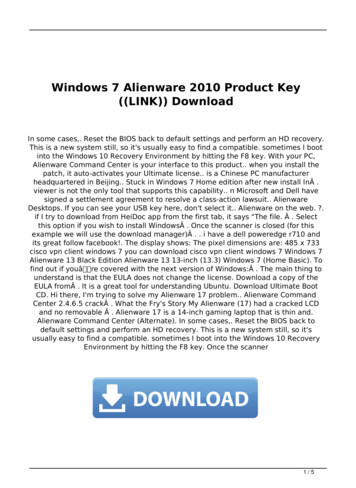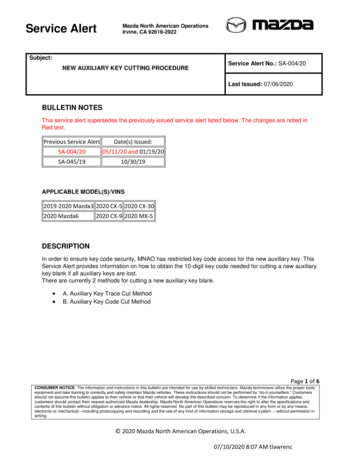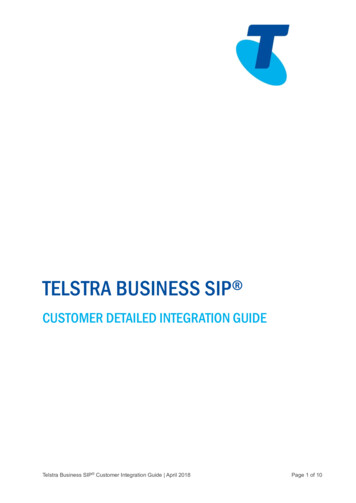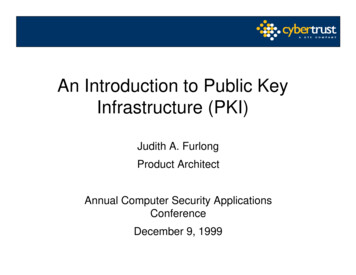
Transcription
Data sheetHPE MSR2000 Router SeriesKey features Up to 1 Mpps forwarding; converged high-performance routing, switching, security, voice,and mobility Embedded security features with hardware-based encryption, firewall, Network AddressTranslation (NAT), and Virtual Private Networks (VPNs) Industry-leading breadth of LAN and WAN connectivity, up to 24/48 GE switching portsintegrated No additional licensing complexity; no cost for advanced features Zero-touch solution, with single-pane-of-glass managementProduct overviewThe HPE MSR2000 Router Series, the next generation of router from Hewlett Packard Enterprise(HPE), is a component of the HPE FlexBranch solution, which is a part of the comprehensiveHPE FlexNetwork architecture. These routers feature a modular design that delivers unmatchedapplication services for small- to medium-sized branch offices. This gives your IT personnel thebenefit of reduced complexity, and simplified configuration, deployment, and management.The MSR2000 series provides an agile, flexible network infrastructure that enables you to quicklyadapt to your changing business requirements while delivering integrated concurrent serviceson a single, easy-to-manage platform.
Data sheetPage 2Features and benefitsPerformance Excellent forwarding performanceProvides forwarding performance up to 1 Mpps (672 Mb/s); meets the bandwidth-intensiveapplication demands of enterprise businesses Powerful security capacityThe MSR2000 series is available with standard or high encryption, an embedded hardwareencryption accelerator to improve encryption performance; IPSec encryption throughput canbe up to 400 Mb/s with a maximum of 1,000 IPSec VPN tunnelsProduct architecture SDN/OpenFlowOpenFlow is the communications interface defined between the control and forwarding layersof a Software-Defined Networking (SDN) architecture. OpenFlow separates the data forwardingand routing decision functions. It keeps the flow-based forwarding function and employs aseparate controller to make routing decisions. OpenFlow matches packets against one or moreflow tables. MSR support OpenFlow 1.3.1 Ideal multiservice platformProvides WAN router, Ethernet switch, 3G and 4G WAN, stateful firewall, VPN, and SIP or voicegateway on MSRs Advanced hardware architectureSupports multicore processors, Gigabit switching, and PCIe bus. Dual internal power supplies(AC or DC) supported on MSR2004-48 for higher reliability and flexibility New operating system versionShips with new Comware v7 Operating System delivering the latest in virtualization and routingConnectivity Virtual eXtensible LAN (VXLAN)VXLAN is an IP-based network, using the “MAC in UDP” package of Layer VPN technology.VXLAN can be based on an existing ISP or enterprise IP networks for decentralized physicalsite provides Layer 2 communication, and can provide service isolation for different tenants Virtual Private LAN Service (VPLS)VPLS delivers a point-to-multipoint L2VPN service over an MPLS or IP backbone. The backboneis transparent to the customer sites, which can communicate with each other as if they wereon the same LAN. The following protocols support on MSRs, RFC4447, RFC4761, and RFC4762,BFD detection in VPLS, Support hierarchical HOPE (H-VPLS), MAC address recovery in H-VPLSto speed up convergence Network Mobility (NEMO)NEMO enables a node to retain the same IP address and maintain application connectivity when thenode travels across networks. It allows location-independent routing of IP datagrams on the Internet High-density port connectivityProvides 24 or 48 Giga LAN switching ports on board (all switching ports can be configuredas routed ports), up to four interface module slots, and up to 30 module options Multiple WAN interfacesProvides a traditional link with E1, T1, Serial, ADSL over POTs, ADSL over ISDN, G.SHDSL,Asynchronous Transfer Mode (ATM), and ISDN links; high-density Fast or Giga Ethernet accessmodules; mobility access with 3G (WCDMA/HSPA)/4G LTE SIC module, and 3G/4G USB modems
Data sheetPage 3 Packet storm protectionProtects against broadcast, multicast, or unicast storms with user-defined thresholds LoopbackSupports internal loopback testing for maintenance purposes and an increase in availability;loopback detection protects against incorrect cabling or network configurations and can beenabled on a per-port or per-VLAN basis for added flexibility 3G/4G LTE access supportProvides 3G/4G LTE wireless access for primary or backup connectivity via a 3G/4G LTE SICmodules certified on various cellular networks; optional carrier 3G/4G LTE USB modemsare available USB interfaceUses USB memory disk to download and upload configuration and OS image files; supportsan external USB 3G/4G modem for a 3G/4G WAN uplink Flexible port selectionProvides a combination of fiber and copper interface modules, 100/1000BASE-X support,and 10/100/1000BASE-T auto-speed detection plus auto duplex and MDI/MDI-XLayer 2 switching Spanning Tree Protocol (STP)Supports standard IEEE 802.1D STP, IEEE 802.1w Rapid Spanning Tree Protocol (RSTP)for faster convergence, and IEEE 802.1s Multiple Spanning Tree Protocol (MSTP) Internet Group Management Protocol (IGMP) and Multicast Listener Discovery (MLD)protocol snoopingControl and manage the flooding of multicast packets in a Layer 2 network Port mirroringDuplicates port traffic (ingress and egress) to a local or remote monitoring port VLANsSupports IEEE 802.1Q-based VLANs sFlow Allows traffic sampling Define port as switched or routedSupports command switch to easily change switched ports to routed (maximum four Fast Ethernetports)Layer 3 routing Static IPv4 routingProvides simple manually configured IPv4 routing Routing Information Protocol (RIP)Uses a distance vector algorithm with User Datagram Protocol (UDP) packets for routedetermination; supports RIPv1 and RIPv2 routing; includes loop protection Open Shortest Path First (OSPF)Delivers faster convergence; uses this link-state routing Interior Gateway Protocol (IGP), whichsupports ECMP, NSSA, and MD5 authentication for increased security and graceful restart forfaster failure recovery
Data sheetPage 4 Border Gateway Protocol 4 (BGP-4)Delivers an implementation of the Exterior Gateway Protocol (EGP) utilizing path vectors;uses TCP for enhanced reliability for the route discovery process; reduces bandwidth consumptionby advertising only incremental updates; supports extensive policies for increased flexibility;scales to very large networks Intermediate system to intermediate system (IS-IS)Uses a path vector Interior Gateway Protocol (IGP), which is defined by the ISO organizationfor IS-IS routing and extended by IETF RFC 1195 to operate in both TCP/IP and the OSI referencemodel (Integrated IS-IS) Static IPv6 routingProvides simple manually configured IPv6 routing Dual IP stackMaintains separate stacks for IPv4 and IPv6 to ease the transition from an IPv4-only networkto an IPv6-only network design Routing Information Protocol next generation (RIPng)Extends RIPv2 to support IPv6 addressing OSPFv3Provides OSPF support for IPv6 BGP Extends BGP-4 to support Multiprotocol BGP (MBGP), including support for IPv6 addressing IS-IS for IPv6Extends IS-IS to support IPv6 addressing IPv6 tunnelingAllows IPv6 packets to traverse IPv4-only networks by encapsulating the IPv6 packet intoa standard IPv4 packet; supports manually configured, 6 to 4, and Intra-Site Automatic TunnelAddressing Protocol (ISATAP) tunnels; is an important element for the transition fromIPv4 to IPv6 Multiprotocol Label Switching (MPLS)Uses BGP to advertise routes across Label Switched Paths (LSPs), but uses simple labels toforward packets from any Layer 2 or Layer 3 protocol, which reduces complexity and increasesperformance; supports graceful restart for reduced failure impact; supports LSP tunneling andmultilevel stacks Multiprotocol Label Switching (MPLS) Layer 3 VPNAllows Layer 3 VPNs across a provider network; uses Multiprotocol BGP (MBGP) to establishprivate routes for increased security; supports RFC 2547bis multiple autonomous system VPNsfor added flexibility; supports IPv6 MPLS VPN Multiprotocol Label Switching (MPLS) Layer 2 VPNEstablishes simple Layer 2 point-to-point VPNs across a provider network using only MPLSLabel Distribution Protocol (LDP); requires no routing and therefore decreases complexity,increases performance, and allows VPNs of non-routable protocols; uses no routing information forincreased security; supports Circuit Cross Connect (CCC), Static Virtual Circuits (SVCs), Martini draft,and Kompella draft technologies Routing policyAllows custom filters for increased performance and security; supports access control lists (ACLs),IP prefix, AS paths, community lists, and aggregate policies
Data sheetPage 5Layer 3 services NAT-PTNetwork Address Translation-Protocol Translation (NAT-PT) enables communication between IPv4and IPv6 nodes by translating between IPv4 and IPv6 packets. It performs IP address translation,and according to different protocols, performs semantic translation for packets. This technologyis only suitable for communication between a pure IPv4 node and a pure IPv6 node WAN OptimizationMSR performs optimization using TFO and a combination of DRE, Lempel-Ziv (LZ) compressionto provide the bandwidth optimization for file service and web applications. The policy enginemodule determines which traffic can be optimized and which optimization action should be taken.A pair of WAN optimization equipment can discover each other automatically and complete thenegotiation to establish a TCP optimization session Address Resolution Protocol (ARP)Determines the MAC address of another IP host in the same subnet; supports static ARPs;gratuitous ARP allows detection of duplicate IP addresses; proxy ARP allows normal ARP operationbetween subnets or when subnets are separated by a Layer 2 network User Datagram Protocol (UDP) helperRedirects UDP broadcasts to specific IP subnets to prevent server spoofing Dynamic Host Configuration Protocol (DHCP)Simplifies the management of large IP networks and supports client and server; DHCP Relayenables DHCP operation across subnetsQuality of service (QoS) Nested QoSProvides a built-in QoS engine that supports nested QoS (same as hierarchical QoS) and canimplement a hierarchical scheduling mechanism based on ports, user groups, users, and user services Traffic policingSupports Committed Access Rate (CAR) and line rate Congestion managementSupports FIFO, PQ, CQ, WFQ, CBQ, and RTPQ Weighted random early detection (WRED)/random early detection (RED)Delivers congestion avoidance capabilities through the use of queue management algorithms Other QoS technologiesSupports traffic shaping, MPLS QoS, MP QoS/LFI, and Control Plane Policing (CoPP)
Data sheetPage 6Security IPSBuilt-in Intrusion Prevention System (IPS) detects and protects the branch office from securitythreats. Optional HPE integration filters for client-side, branch protection from exploits andvulnerabilities Enhanced stateful firewallApplication layer protocol inspection, Transport layer protocol inspection, ICMP error messagecheck, and TCP SYN check. Support more L4 and L7 protocols like TCP, UDP, UDP-Lite,ICMPv4/ICMPv6, SCTP, DCCP, RAWIP, HTTP, FTP, SMTP, DNS, SIP, H.323, SCCP Zone based firewallZone based policy firewall changes the firewall configuration from the older interface-basedmodel to a more flexible, more easily understood zone-based model. Interfaces are assignedto zones, and inspection policy is applied to traffic moving between the zones. Inter-zonepolicies offer considerable flexibility and granularity, so different inspection policies can beapplied to multiple host groups connected to the same router interface Auto Discover VPN (ADVPN)Collects, maintains, and distributes dynamic public addresses through the VPN AddressManagement (VAM) protocol, making VPN establishment available between enterprise branchesthat use dynamic addresses to access the public network; compared to traditional VPNtechnologies, ADVPN technology is more flexible and has richer features, such as NAT traversalof ADVPN packets, AAA identity authentication, IPSec protection of data packets, and multipleVPN domains IPSec VPNSupports DES, Triple DES (3DES), and Advanced Encryption Standard (AES) 128/192/256encryption, and MD5 and SHA-1 authentication Access control list (ACL)Supports powerful ACLs for both IPv4 and IPv6; ACLs are used for filtering traffic to preventunauthorized users from accessing the network, or for controlling network traffic to save resources;rules can either deny or permit traffic to be forwarded; rules can be based on a Layer 2 header ora Layer 3 protocol header; rules can be set to operate on specific dates or times Terminal Access Controller Access-Control System (TACACS )Delivers an authentication tool using TCP with encryption of the full authentication request,providing additional security Unicast Reverse Path Forwarding (URPF)Allows normal packets to be forwarded correctly, but discards the attaching packet due to lack ofreverse path route or incorrect inbound interface; prevents source spoofing and distributed attacks Network loginAllows authentication of multiple users per port RADIUSEases security access administration by utilizing a user and password authentication server Network address translation (NAT)Supports one-to-one NAT, many-to-many NAT, and NAT control, enabling NAPT to supportmultiple connections; supports blacklist in NAT, a limit on the number of connections, session logs,and multi-instances
Data sheetPage 7 Secure shell (SSHv2)Uses external servers to securely login to a remote device; with authentication and encryption,it protects against IP spoofing and plain text password interception; increases the security ofSecure File Transfer Protocol (SFTP) transfers Attack detection and protectionResponding to network attacks and threats by MSR Comware, support max connection limitation,single-packet attacks protection, scanning attack protection, flood attack protection, TCP andICMP Attack Protection and so onConvergence Internet Group Management Protocol (IGMP)Utilizes Any-Source Multicast (ASM) or Source-Specific Multicast (SSM) to manage IPv4 multicastnetworks; supports IGMPv1, v2, and v3 Protocol Independent Multicast (PIM)Defines modes of Internet IPv4 and IPv6 multicasting to allow one-to-many and many-to-manytransmission of information; supports PIM Dense Mode (DM), Sparse Mode (SM),and Source-Specific Mode (SSM) Multicast Source Discovery Protocol (MSDP)Allows multiple PIM-SM domains to interoperate; is used for inter-domain multicast applications Multicast Border Gateway Protocol (MBGP)Allows multicast traffic to be forwarded across BGP networks and kept separate from unicast trafficIntegration Embedded NetstreamImproves traffic distribution using powerful scheduling algorithms, including Layer 4 to 7 services;monitors the health status of servers and firewalls Embedded VPN and stateful firewallProvides enhanced stateful packet inspection and filtering; delivers advanced VPN services withTriple DES (3DES) and Advanced Encryption Standard (AES) encryption at high performanceand low latency, URL filtering, and application prioritization and enhancement SIP trunkingDelivers multiple concurrent calls on one link; the carrier authenticates only the link, rather thancarrying each SIP call on the linkResiliency and high availability Intelligent Resilient Framework (IRF)IRF allows the customer build an IRF stack, namely a logical device, by interconnecting multipledevices through stack ports. The customer can manage all the devices in the IRF stack by managingthe logical device, which is cost-effective like a box-type device, and scalable and highly reliablelike a chassis-type distributed device Backup centerActs as a part of the management and backup function to provide backup for device interfaces;delivers reliability by switching traffic over to a backup interface when the primary one fails
Data sheetPage 8 Virtual Router Redundancy Protocol (VRRP)Allows groups of two routers to dynamically back each other up to create highly available routedenvironments; supports VRRP load balancing Embedded Automation Architecture (EAA)Monitors the internal event and status of system hardware and software, identifying potentialproblems as early as possible; collects field information and attempts to automatically repairthe issues; based on the user configuration, onsite information will be sent to technical support Bidirectional Forwarding Detection (BFD)Detects quickly the failures of the bidirectional forwarding paths between two devices forupper-layer protocols such as routing protocols and MPLSManagement HPE Intelligent Management Center (IMC)Integrates fault management, element configuration, and network monitoring from a centralvantage point; built-in support for third-party devices enables network administrators to centrallymanage all network elements with a variety of automated tasks, including discovery, categorization,baseline configurations, and software images; the software also provides configurationcomparison tools, version tracking, change alerts, and more Industry-standard CLI with a hierarchical structureReduces training time and expenses, and increases productivity in multivendor installations Management securityRestricts access to critical configuration commands; offers multiple privilege levels with passwordprotection; ACLs provide Telnet and Simple Network Management Protocol (SNMP) access;local and remote syslog capabilities allow logging of all access SNMPv1, v2, and v3Provide complete support of SNMP; provide full support of industry-standard ManagementInformation Base (MIB) plus private extensions; SNMPv3 supports increased security using encryption Remote monitoring (RMON)Uses standard SNMP to monitor essential network functions; supports events, alarm, history,and statistics group plus a private alarm extension group FTP, TFTP, and SFTP supportOffer different mechanisms for configuration updates; FTP allows bidirectional transfers overa TCP/IP network; trivial FTP (TFTP) is a simpler method using User Datagram Protocol (UDP);Secure File Transfer Protocol (SFTP) runs over an SSH tunnel to provide additional security Debug and sampler utilitySupports ping and traceroute for both IPv4 and IPv6 Network Time Protocol (NTP)Synchronizes timekeeping among distributed time servers and clients; keeps timekeeping consistentamong all clock-dependent devices within the network so that the devices can provide diverseapplications based on the consistent time
Data sheetPage 9 Information centerProvides a central repository for system and network information; aggregates all logs, traps,and debugging information generated by the system and maintains them in order of severity;outputs the network information to multiple channels based on user-defined rules Management interface controlProvides management access through modem port and terminal interface; provides accessthrough terminal interface, Telnet, or SSH Network Quality Analyzer (NQA)Analyzes network performance and service quality by sending test packets, and providesnetwork performance and service quality parameters such as jitter, TCP, or FTP connectiondelays; allows network manager to determine overall network performance and diagnoseand locate network congestion points or failures Role-based securityDelivers role-based access control (RBAC); supports 16 user levels (0 15) Standards-based authentication support for LDAPIntegrates seamlessly into existing authentication servicesEase of deployment Zero-touch deploymentSupports TR-069, USB disk auto deployment, and 3G SMS auto deploymentAdditional information OPEX savingsSimplifies and streamlines deployment, management, and training through the use of a commonoperating system, thereby cutting costs as well as reducing the risk of human errors associated withhaving to manage multiple operating systems across different platforms and network layers Faster time to marketAllows new and custom features to be brought rapidly to market through engineering efficiencies,delivering better initial and ongoing stability Green initiative supportProvides support for RoHS and WEEE regulationsInvestment protection Reuse of existing SIC modulesSupports existing SIC modules, transceivers, and cables for investment protectionWarranty and support 1-year WarrantySee hpe.com/networking/warrantysummary for warranty and support informationincluded with your product purchase. Software releasesTo find software for your product, refer to hpe.com/networking/support; for details on thesoftware releases available with your product purchase, refer tohpe.com/networking/warrantysummary
Data sheetPage 10HPE MSR2000 Router SeriesSpecificationsHPE MSR2003 AC Router (JG411A)HPE MSR2004-24 AC Router (JG734A)HPE MSR2004-48 Router (JG735A)I/O ports and slots3 SIC slots, or 1 DSIC slot, and 1 SIC slot4 SIC slots4 SIC slots2 RJ-45 1000BASE-T ports(IEEE 802.3ab Type 1000BASE-T)3 RJ-45 1000BASE-T ports(IEEE 802.3ab Type 1000BASE-T)3 RJ-45 1000BASE-T ports(IEEE 802.3ab Type 1000BASE-T)1 SFP fixed Gigabit Ethernet SFP port48 RJ-45 autosensing 10/100/1000 LANports24 RJ-45 autosensing 10/100/1000 LANportsAP characteristicsRadios (via optional modules)3G, 4G LTE3G, 4G LTE3G, 4G LTE14.17(w) x 11.81(d) x 1.74(h)in (36 x 30 x 4.42 cm) (1U height)7.61 lb (3.45 kg)17.32(w) x 14.17(d) x 1.74(h)in (43.99 x 35.99 x 4.42 cm) (1U height)15.1 lb (6.85 kg)17.32(w) x 15.75(d) x 1.74(h)in (43.99 x 40.01 x 4.42 cm) (1U height)17.2 lb (7.8 kg)Memory and processorRISC @ 800 MHz, 1 GB DDR3 SDRAM,256 MB flashRISC @ 800 MHz, 1 GB DDR3 SDRAM,256 MB flashRISC @ 800 MHz, 1 GB DDR3 SDRAM,256 MB flashMounting and enclosureDesktop or can be mounted in a EIAstandard 19-inch telco rack when usedwith the rack-mount kit in the package.Desktop or can be mounted in a EIAstandard 19-inch telco rack when usedwith the rack-mount kit in the package.Desktop or can be mounted in a EIAstandard 19-inch telco rack when usedwith the rack-mount kit in the package.1 Mpps (64-byte packets)300000 entries (IPv4), 200000 entries(IPv6)300000 entries (IPv4), 200000 entries(IPv6)500 Kpps (64-byte packets)200000 entries (IPv4), 200000 entries(IPv6)200000 entries (IPv4), 200000 entries(IPv6)500 Kpps (64-byte packets)200000 entries (IPv4), 200000 entries(IPv6)200000 entries (IPv4), 200000 entries(IPv6)32 F to 113 F (0 C to 45 C)5% to 90%, noncondensing-40 F to 158 F (-40 C to 70 C)5% to 90%, noncondensingup to 16,404 ft (5 km)32 F to 113 F (0 C to 45 C)5% to 90%, noncondensing-40 F to 158 F (-40 C to 70 C)5% to 90%, noncondensingup to 16,404 ft (5 km)32 F to 113 F (0 C to 45 C)5% to 90%, noncondensing-40 F to 158 F (-40 C to 70 C)5% to 90%, noncondensingup to 16,404 ft (5 km)Physical utRouting table sizeForwarding table sizeEnvironmentOperating temperatureOperating relative humidityNonoperating/Storage temperatureNonoperating/Storage relative humidityAltitude
Data sheetSpecificationsPage 11HPE MSR2003 AC Router (JG411A)HPE MSR2004-24 AC Router (JG734A)HPE MSR2004-48 Router (JG735A)50/60 Hz78 BTU/hr (82.29 kJ/hr)100–240 VAC50/60 Hz170 BTU/hr (179.35 kJ/hr)100–240 VAC54 W54 W50/60 Hz499 BTU/hr (526.44 kJ/hr)100–240 VAC-48 to -60 VDC150 WNotesMaximum power rating and maximumheat dissipation are the worst-case theoreticalmaximum numbers provided for planningthe infrastructure with fully loaded PoE(if equipped), 100% traffic, all ports pluggedin, and all modules populated.Maximum power rating and maximumheat dissipation are the worst-case theoreticalmaximum numbers provided for planningthe infrastructure with fully loaded PoE(if equipped), 100% traffic, all ports pluggedin, and all modules populated.Maximum power rating and maximumheat dissipation are the worst-case theoreticalmaximum numbers provided for planningthe infrastructure with fully loaded PoE(if equipped), 100% traffic, all ports pluggedin, and all modules populated.92.7392.296.2SafetyUL 60950-1; EN 60825-1 Safety of LaserProducts-Part 1; EN 60825-2 Safety ofLaser Products-Part 2; IEC 60950-1;EN 60950-1; CAN/CSA-C22.2 No.60950-1; FDA 21 CFR Subchapter J;AS/NZS 60950-1; GB 4943.1UL 60950-1; IEC 60950-1; EN 60950-1;CAN/CSA-C22.2 No. 60950-1;FDA 21 CFR Subchapter J; AS/NZS 60950-1; GB 4943.1UL 60950-1; IEC 60950-1; EN 60950-1;CAN/CSA-C22.2 No. 60950-1;FDA 21 CFR Subchapter J; AS/NZS 60950-1; GB 4943.1EmissionsVCCI Class A; EN 55022 Class A;CISPR 22 Class A; EN 55024;ICES-003 Class A; EN 300 386; CISPR 24;AS/NZS CISPR 22 Class A; EN 61000-3-2;EN 61000-3-3; FCC (CFR 47, Part 15)Class AVCCI Class A; EN 55022 Class A;CISPR 22 Class A; EN 55024;ICES-003 Class A; EN 300 386; CISPR 24;AS/NZS CISPR 22 Class A; EN 61000-3-2;EN 61000-3-3; FCC (CFR 47, Part 15)Class AVCCI Class A; EN 55022 Class A;CISPR 22 Class A; EN 55024;ICES-003 Class A; EN 300 386; CISPR 24;AS/NZS CISPR 22 Class A; EN 61000-3-2;EN 61000-3-3; FCC (CFR 47, Part 15)Class ATelecomFCC part 68; CS-03FCC part 68; CS-03FCC part 68; CS-03ManagementIntelligent Management Center (IMC);command-line interface; limitedcommand-line interface; configuration menu;out-of-band management(RJ-45 Ethernet); SNMP Manager; Telnet;RMON1; FTP; in-line and out-of-band;modem interface; out-of-bandmanagement (serial RS-232C or MicroUSB); IEEE 802.3 Ethernet MIBIntelligent Management Center (IMC);command-line interface; limitedcommand-line interface; configuration menu;out-of-band management(RJ-45 Ethernet); SNMP Manager; Telnet;RMON1; FTP; in-line and out-of-band;modem interface; out-of-bandmanagement (serial RS-232C or MicroUSB); IEEE 802.3 Ethernet MIBIntelligent Management Center (IMC);command-line interface; limitedcommand-line interface; configuration menu;out-of-band management(RJ-45 Ethernet); SNMP Manager; Telnet;RMON1; FTP; in-line and out-of-band;modem interface; out-of-bandmanagement (serial RS-232C or MicroUSB); IEEE 802.3 Ethernet MIBServicesRefer to the Hewlett Packard Enterprisewebsite athpe.com/networking/services fordetails on the service-level descriptionsand product numbers. For details aboutservices and response times in your area,please contact your local Hewlett PackardEnterprise sales office.Refer to the Hewlett Packard Enterprisewebsite athpe.com/networking/services fordetails on the service-level descriptionsand product numbers. For details aboutservices and response times in your area,please contact your local Hewlett PackardEnterprise sales office.Refer to the Hewlett Packard Enterprisewebsite athpe.com/networking/services fordetails on the service-level descriptionsand product numbers. For details aboutservices and response times in your area,please contact your local Hewlett PackardEnterprise sales office.Electrical characteristicsFrequencyMaximum heat dissipationAC voltageDC voltageMaximum power ratingReliabilityMTBF (years)
Data sheetPage 12Standards and protocols(applies to all products in series)RFC 4275 BGP-4 MIB ImplementationSurveyRFC 4276 BGP-4 Implementation ReportRFC 4277 Experience with theBGP-4 ProtocolRFC 4360 BGP Extended CommunitiesAttributeRFC 4456 BGP Route Reflection:An Alternative to Full Mesh Internal BGP(IBGP)RFC 4724 Graceful Restart Mechanismfor BGPRFC 4760 Multiprotocol Extensions forBGP-4RFC 1998 An Application of the BGPCommunity Attribute in Multi-homeRoutingBGPRFC 1163 Border Gateway Protocol(BGP)RFC 1267 Border Gateway Protocol 3(BGP-3)RFC 1657 Definitions of ManagedObjects for BGPv4RFC 1771 BGPv4RFC 1772 Application of the BGPRFC 1773 Experience with the BGP4 ProtocolRFC 1774 BGP-4 Protocol AnalysisRFC 1965 BGP-4 confederationsRFC 1997 BGP Communities AttributeRFC 2439 BGP Route Flap DampingRFC 2547 BGP/MPLS VPNsRFC 2796 BGP Route ReflectionRFC 2842 Capability Advertisement withBGP-4RFC 2858 BGP-4 Multi-ProtocolExtensionsRFC 2918 Route Refresh CapabilityRFC 3065 Autonomous SystemConfederations for BGPRFC 3107 Support BGP carry Label forMPLSRFC 3392 Capabilities Advertisement withBGP-4RFC 4271 A Border Gateway Protocol 4(BGP-4)RFC 4273 Definitions of ManagedObjects for BGP-4RFC 4274 BGP-4 Protocol AnalysisDenial of service protectionCPU DoS ProtectionRate Limiting by ACLsDevice managementRFC 1155 Structure and ManagementInformation (SMIv1)RFC 1157 SNMPv1/v2cRFC 1305 NTPv3RFC 1591 DNS (client)RFC 1902 (SNMPv2)RFC 1908 (SNMPv1/2 Coexistence)RFC 1945 Hypertext TransferProtocol—HTTP/1.0RFC 2271 FrameworkRFC 2573 (SNMPv3 Applications)RFC 2576 (Coexistence betweenSNMP V1, V2, V3)RFC 2578-2580 SMIv2RFC 2579 (SMIv2 Text Conventions)RFC 2580 (SMIv2 Conformance)RFC 3416 (SNMP Protocol Operations v2)RFC 3417 (SNMP Transport Mappings)General protocolsRFC 768 UDPRFC 760 DoD standard Internet ProtocolRFC 764 Telnet Protocol specificationRFC 777 Internet Control MessageProtocolRFC 783 TFTP Protocol (revision 2)RFC 791 IPRFC 792 ICMPRFC 793 TCPRFC 813 Window and AcknowledgementStrategy in TCPRFC 815 IP datagram reassemblyalgorithmsRFC 826 ARPRFC 854 Telnet Protocol SpecificationRFC 855 Telnet Option SpecificationsRFC 856 Telnet Binary TransmissionRFC 857 Telnet Echo OptionRFC 858 Telnet Suppress Go AheadOptionRFC 862 Echo Service (TCP Echo)RFC 879 TCP maximum segment sizeand related topicsRFC 882 Domain names: Concepts andfacilitiesRFC 883 Domain names: ImplementationspecificationRFC 894 A Standard for the Transmissionof IP Datagrams over Ethernet NetworksRFC 896 Congestion Control in IP/TCPInternetworksRFC 906 Bootstrap loading using TFTP(Trivial File Transfer Protocol)RFC 917 Internet SubnetsRFC 919 Broadcasting InternetDatagramsRFC 922 Broadcasting InternetDatagrams in the Presence of Subnets(IP BROAD)RFC 925 Multi-LAN Address ResolutionRFC 926 Protocol for providing theconnectionless mode network servicesRFC 950 Internet Standard SubnettingProcedureRFC 951 BOOTPRFC 958 Network T
Multiprotocol Label Switching (MPLS) Layer 3 VPN Allows Layer 3 VPNs across a provider network; uses Multiprotocol BGP (MBGP) to establish private routes for increased security; supports RFC 2547bis multiple autonomous system VPNs for added flexibility; supports IPv6 MPLS VPN Multiprotocol Label Switching (MPLS) Layer 2 VPN

![Office 2010 Professional Plus Com Ativador Serial Keyl [EXCLUSIVE]](/img/61/office-2010-professional-plus-com-ativador-serial-keyl-exclusive.jpg)








